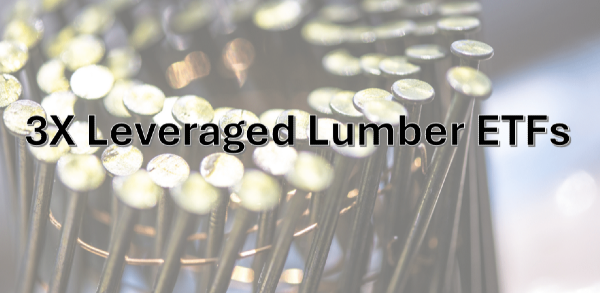As of 2025 Q2, the only leveraged ETF tangential to the lumber industry is the NAIL ETF.
NAIL, the Direxion Daily Homebuilders & Supplies Bull 3X ETF, seeks to provide three times the daily performance of the Dow Jones U.S. Select Home Construction Index. It offers leveraged exposure to homebuilders and suppliers, making it a high-risk, high-reward option for short-term traders. With an expense ratio of 0.95% and holdings in major home construction companies like D.R. Horton and Lennar, NAIL is best suited for investors who actively manage their positions.
Exchange-Traded Funds (ETFs) have revolutionized investing by offering diversified exposure to various asset classes while maintaining liquidity and cost efficiency. Unlike mutual funds, ETFs trade on stock exchanges, allowing investors to buy and sell shares throughout the trading day. Leveraged ETFs take this concept further by using financial derivatives and debt to amplify returns, often by a factor of two or three. Lumber ETFs, specifically, play a crucial role in the construction and commodities sectors, providing investors with exposure to timberland REITs, forestry companies, and lumber producers. This article aims to explore the mechanics, risks, and potential benefits of 3X leveraged lumber ETFs, helping investors make informed decisions.
Understanding Leveraged ETFs
Leveraged ETFs are designed to deliver multiples of the daily performance of an underlying index or asset. They achieve this by utilizing financial derivatives such as swaps and futures contracts, which allow them to magnify returns. However, this leverage comes with inherent risks, including volatility and compounding effects that can erode gains over time. While leveraged ETFs can provide significant short-term gains, they are not ideal for long-term holding due to the daily reset mechanism. A common misconception is that leveraged ETFs will always track their benchmark proportionally over extended periods, but due to compounding, their performance can deviate significantly.
Overview of the Lumber Industry
Lumber is a critical commodity in global markets, serving as a fundamental material for construction, furniture, and paper production. Its pricing is influenced by several key factors, including housing market demand, supply chain disruptions, and tariffs on imported timber. Major players in the industry include timberland REITs such as Weyerhaeuser and Rayonier, as well as forestry companies that manage large-scale timber operations. Historically, lumber has demonstrated cyclical price movements, often driven by economic conditions and infrastructure development. Understanding these dynamics is essential for investors looking to capitalize on lumber ETFs, particularly those with leveraged exposure.
What Are 3X Leveraged Lumber ETFs?
3X leveraged lumber ETFs are specialized exchange-traded funds designed to amplify the daily price movements of lumber-related assets. These funds use financial derivatives and debt to achieve three times the daily return of their underlying index. While this leverage can lead to significant short-term gains, it also increases exposure to market volatility. Investors should be aware that leveraged ETFs reset daily, meaning their long-term performance may diverge from expectations due to compounding effects. Currently, there are limited options for 3X leveraged lumber ETFs, but broader leveraged commodity ETFs may provide indirect exposure. Compared to traditional lumber ETFs, leveraged versions are more suitable for active traders rather than long-term investors due to their inherent risks.
Key Features of 3X Leveraged Lumber ETFs
Investing in 3X leveraged lumber ETFs comes with unique structural considerations, including higher expense ratios and management fees. These funds typically have higher costs due to the complexity of maintaining leverage through derivatives. Holdings within these ETFs often include timberland REITs, forestry companies, and lumber producers, providing diversified exposure to the sector. Liquidity is another crucial factor, as leveraged ETFs tend to have higher trading volumes but may experience price discrepancies during volatile market conditions. Additionally, dividend yields and reinvestment strategies vary, with some funds reinvesting earnings to maintain leverage while others distribute dividends to investors.
Risks and Challenges of Investing in 3X Leveraged Lumber ETFs
The primary risk associated with 3X leveraged lumber ETFs is extreme volatility, as price fluctuations are magnified threefold. During market downturns, these ETFs can suffer significant losses due to compounding effects, making them unsuitable for passive investors. Another challenge is the decay effect caused by daily rebalancing, which can erode returns over time, especially in choppy markets. Given these risks, leveraged lumber ETFs are best suited for experienced traders who actively manage their positions rather than long-term investors seeking stable returns.
Strategies for Investing in 3X Leveraged Lumber ETFs
Investors considering 3X leveraged lumber ETFs must decide between short-term trading and long-term holding. Due to daily compounding effects, these ETFs are best suited for short-term strategies, where traders capitalize on rapid price movements. Technical analysis plays a crucial role in determining entry and exit points, with indicators like moving averages and relative strength index (RSI) helping traders identify trends. Hedging strategies can mitigate risk by pairing leveraged lumber ETFs with other asset classes, such as real estate or commodities, to balance exposure. Additionally, portfolio diversification with lumber ETFs allows investors to spread risk across timberland REITs, forestry companies, and construction materials.
Comparing 3X Leveraged Lumber ETFs to Other Investment Options
Traditional lumber ETFs provide stable exposure to the timber industry, whereas leveraged ETFs amplify daily price movements, making them riskier. Investors may also consider individual lumber stocks, which offer direct ownership but require extensive research and management. Alternative commodities ETFs, such as those focused on timber, forestry, and construction materials, provide diversified exposure to related industries. Compared to futures contracts, leveraged ETFs offer easier access and lower margin requirements but suffer from performance decay due to daily rebalancing.
Regulatory and Tax Considerations
The SEC imposes strict regulations on leveraged ETFs, emphasizing their risks and suitability for experienced traders. Tax implications vary, with short-term capital gains taxed at higher rates than long-term holdings. Investors should also be aware of wash sale rules, which can disallow losses if similar securities are repurchased within 30 days. Best practices for tax-efficient investing in ETFs include utilizing tax-advantaged accounts and selecting funds with minimal capital gains distributions. Understanding these factors can help investors optimize returns while managing risks effectively.
Conclusion
3X leveraged lumber ETFs offer amplified exposure to the timber industry, making them ideal for short-term traders but risky for long-term investors due to volatility and compounding effects. Understanding key features, investment strategies, and regulatory considerations is crucial for optimizing returns while managing risks. By comparing leveraged ETFs with traditional lumber ETFs, individual stocks, and futures contracts, investors can make informed decisions aligned with their financial goals.






























NAIL, the Direxion Daily Homebuilders & Supplies Bull 3X ETF, seeks to provide three times the daily performance of the Dow Jones U.S. Select Home Construction Index. It offers leveraged exposure to homebuilders and suppliers, making it a high-risk, high-reward option for short-term traders. With an expense ratio of 0.95% and holdings in major home construction companies like D.R. Horton and Lennar, NAIL is best suited for investors who actively manage their positions.
Exchange-Traded Funds (ETFs) have revolutionized investing by offering diversified exposure to various asset classes while maintaining liquidity and cost efficiency. Unlike mutual funds, ETFs trade on stock exchanges, allowing investors to buy and sell shares throughout the trading day. Leveraged ETFs take this concept further by using financial derivatives and debt to amplify returns, often by a factor of two or three. Lumber ETFs, specifically, play a crucial role in the construction and commodities sectors, providing investors with exposure to timberland REITs, forestry companies, and lumber producers. This article aims to explore the mechanics, risks, and potential benefits of 3X leveraged lumber ETFs, helping investors make informed decisions.
Understanding Leveraged ETFs
Leveraged ETFs are designed to deliver multiples of the daily performance of an underlying index or asset. They achieve this by utilizing financial derivatives such as swaps and futures contracts, which allow them to magnify returns. However, this leverage comes with inherent risks, including volatility and compounding effects that can erode gains over time. While leveraged ETFs can provide significant short-term gains, they are not ideal for long-term holding due to the daily reset mechanism. A common misconception is that leveraged ETFs will always track their benchmark proportionally over extended periods, but due to compounding, their performance can deviate significantly.
Overview of the Lumber Industry
Lumber is a critical commodity in global markets, serving as a fundamental material for construction, furniture, and paper production. Its pricing is influenced by several key factors, including housing market demand, supply chain disruptions, and tariffs on imported timber. Major players in the industry include timberland REITs such as Weyerhaeuser and Rayonier, as well as forestry companies that manage large-scale timber operations. Historically, lumber has demonstrated cyclical price movements, often driven by economic conditions and infrastructure development. Understanding these dynamics is essential for investors looking to capitalize on lumber ETFs, particularly those with leveraged exposure.
What Are 3X Leveraged Lumber ETFs?
3X leveraged lumber ETFs are specialized exchange-traded funds designed to amplify the daily price movements of lumber-related assets. These funds use financial derivatives and debt to achieve three times the daily return of their underlying index. While this leverage can lead to significant short-term gains, it also increases exposure to market volatility. Investors should be aware that leveraged ETFs reset daily, meaning their long-term performance may diverge from expectations due to compounding effects. Currently, there are limited options for 3X leveraged lumber ETFs, but broader leveraged commodity ETFs may provide indirect exposure. Compared to traditional lumber ETFs, leveraged versions are more suitable for active traders rather than long-term investors due to their inherent risks.
Key Features of 3X Leveraged Lumber ETFs
Investing in 3X leveraged lumber ETFs comes with unique structural considerations, including higher expense ratios and management fees. These funds typically have higher costs due to the complexity of maintaining leverage through derivatives. Holdings within these ETFs often include timberland REITs, forestry companies, and lumber producers, providing diversified exposure to the sector. Liquidity is another crucial factor, as leveraged ETFs tend to have higher trading volumes but may experience price discrepancies during volatile market conditions. Additionally, dividend yields and reinvestment strategies vary, with some funds reinvesting earnings to maintain leverage while others distribute dividends to investors.
Risks and Challenges of Investing in 3X Leveraged Lumber ETFs
The primary risk associated with 3X leveraged lumber ETFs is extreme volatility, as price fluctuations are magnified threefold. During market downturns, these ETFs can suffer significant losses due to compounding effects, making them unsuitable for passive investors. Another challenge is the decay effect caused by daily rebalancing, which can erode returns over time, especially in choppy markets. Given these risks, leveraged lumber ETFs are best suited for experienced traders who actively manage their positions rather than long-term investors seeking stable returns.
Strategies for Investing in 3X Leveraged Lumber ETFs
Investors considering 3X leveraged lumber ETFs must decide between short-term trading and long-term holding. Due to daily compounding effects, these ETFs are best suited for short-term strategies, where traders capitalize on rapid price movements. Technical analysis plays a crucial role in determining entry and exit points, with indicators like moving averages and relative strength index (RSI) helping traders identify trends. Hedging strategies can mitigate risk by pairing leveraged lumber ETFs with other asset classes, such as real estate or commodities, to balance exposure. Additionally, portfolio diversification with lumber ETFs allows investors to spread risk across timberland REITs, forestry companies, and construction materials.
Comparing 3X Leveraged Lumber ETFs to Other Investment Options
Traditional lumber ETFs provide stable exposure to the timber industry, whereas leveraged ETFs amplify daily price movements, making them riskier. Investors may also consider individual lumber stocks, which offer direct ownership but require extensive research and management. Alternative commodities ETFs, such as those focused on timber, forestry, and construction materials, provide diversified exposure to related industries. Compared to futures contracts, leveraged ETFs offer easier access and lower margin requirements but suffer from performance decay due to daily rebalancing.
Regulatory and Tax Considerations
The SEC imposes strict regulations on leveraged ETFs, emphasizing their risks and suitability for experienced traders. Tax implications vary, with short-term capital gains taxed at higher rates than long-term holdings. Investors should also be aware of wash sale rules, which can disallow losses if similar securities are repurchased within 30 days. Best practices for tax-efficient investing in ETFs include utilizing tax-advantaged accounts and selecting funds with minimal capital gains distributions. Understanding these factors can help investors optimize returns while managing risks effectively.
Conclusion
3X leveraged lumber ETFs offer amplified exposure to the timber industry, making them ideal for short-term traders but risky for long-term investors due to volatility and compounding effects. Understanding key features, investment strategies, and regulatory considerations is crucial for optimizing returns while managing risks. By comparing leveraged ETFs with traditional lumber ETFs, individual stocks, and futures contracts, investors can make informed decisions aligned with their financial goals.